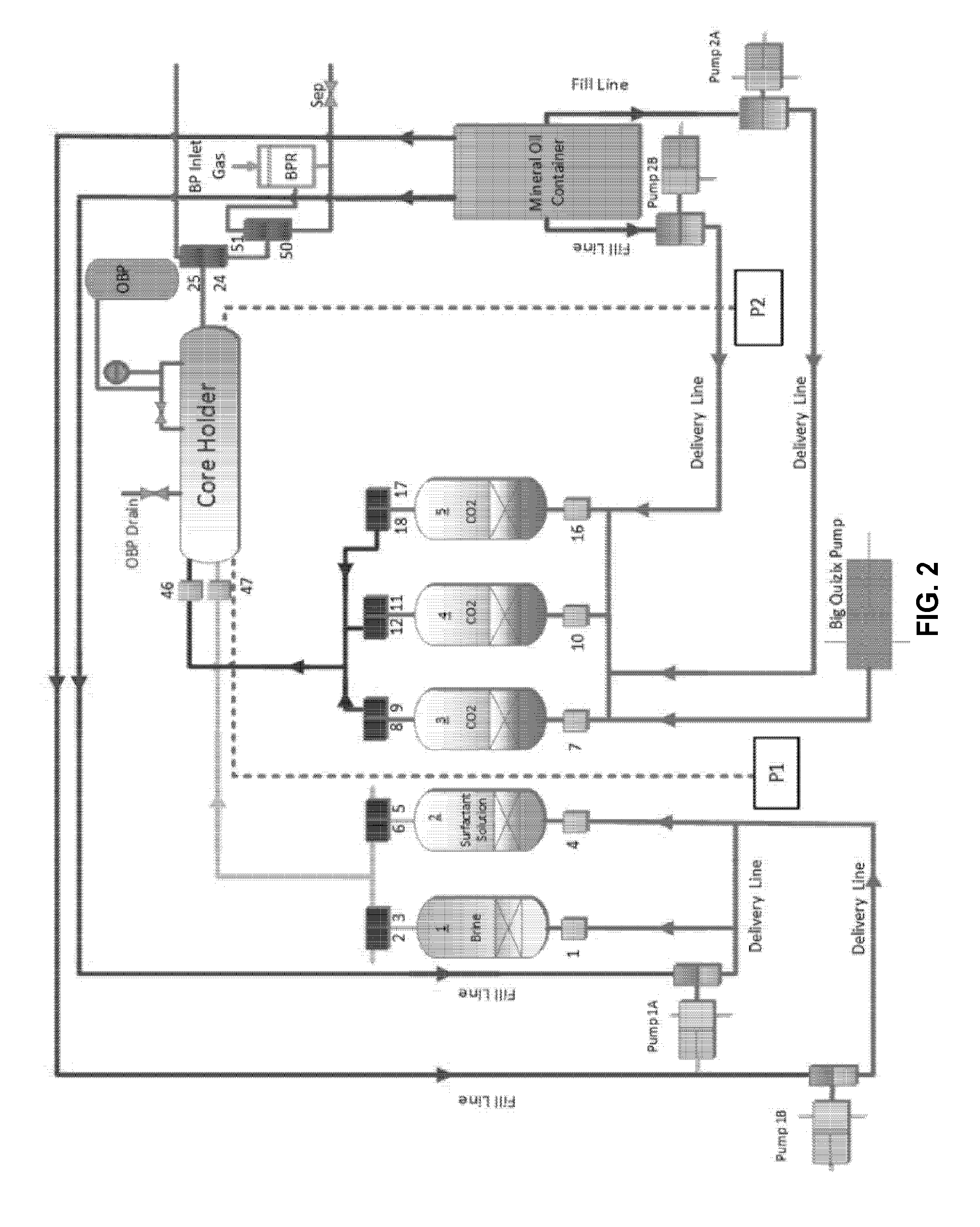Oil recovery processes at high salinity carbonate reservoirs
a high salinity carbonate and oil recovery technology, applied in the direction of sustainable manufacturing/processing, fluid removal, borehole/well accessories, etc., can solve the problems of low oil mobility, inability to use these materials as surfactants, and cost-effective addition, etc., to reduce the viscosity
- Summary
- Abstract
- Description
- Claims
- Application Information
AI Technical Summary
Benefits of technology
Problems solved by technology
Method used
Image
Examples
example 1
Materials
Core Samples
[0095]Indiana Limestone cores of 12″ length and 1.5″ diameter were used in all the experiments. The core samples were procured form Kocurek Industries (USA). The supplier specified porosity and permeability values were 19% and 70 and respectively.
Salts
[0096]Five different salts were needed to prepare both the synthetic formation and injection brines. These salts were Sodium Chloride (NaCl), Sodium Hydroxide (NaOH), Sodium carbonate (Na2CO3), Calcium Chloride (CaCl2) and Magnesium Chloride (MgCl2).
Brines
[0097]Two types of brines were required for the experiments: Formation brine to saturate the core initially and injection brine for water-flooding. The concentrations of the brines resemble Saudi reservoir connate water and sea water for saturation and injection respectively. The brines were stirred and heated for 48 hours prior to usage in the experiments. Table 1 shows the concentration of the two brine solutions. TDS indicates the total dissolved solids (TDS) o...
example 2
Equipment
Core-flooding Experimental Setup
[0102]The core-flooding system used herein is basically a reservoir condition condensate depletion system that was modified to suit the required specifications. The schematic of the core-flooding experimental system is shown in FIG. 2. The system includes an oven, five floating piston fluid cylinders of various volumes, Quizix pumping system, back pressure regulator and the core holder. The components of the flow, control and measurement systems are installed on the ends of the oven, on its roof, as well as within the oven itself. The system includes 72 air operated solenoid valves that are controlled by a software program on a dedicated computer. The flow control system components are all inside the oven. All the pressure transducers and Quizix pump controllers are external to the oven. The system is hooked up to an automatic data logging system which works with the software to record all the data during the experiments in a Microsoft Excel ...
example 3
Experimental Plan
[0114]A number of experiments were planned in which the parameters were varied to accommodate the effect of various factors on the increase in oil recovery. Three injection strategies were considered:[0115]1. CO2 Flooding—Base case.[0116]2. Alternate Surfactant and CO2 Flooding—Slugs of different ratios of surfactant solution and CO2 were injected alternatively in subsequent experiments.[0117]3. Continuous Surfactant and CO2 Flooding—Surfactant solution and CO2 was injected simultaneously.
[0118]The experiments were designed to depict reservoir conditions, thus some of the parameters were kept constant. These include:[0119]Temperature: 90° C.[0120]Pressure: 2500 psi (overburden pressure) or 1800 psi (backpressure)[0121]Crude Oil: Uthmaniya dead oil (30.1° API)[0122]Core: Indiana Limestone 12″×1.5″.[0123]Brine Salinity: Connate Water=213,734 TDS; Injection Brine=57,670 TDS[0124]Oil Soak Period: 5 days (aging time)[0125]Injection Flow Rates: Oil=0.25 cc / min; Water=0.5 ...
PUM
| Property | Measurement | Unit |
|---|---|---|
| volume ratio | aaaaa | aaaaa |
| temperature | aaaaa | aaaaa |
| critical pressure | aaaaa | aaaaa |
Abstract
Description
Claims
Application Information
 Login to View More
Login to View More - R&D
- Intellectual Property
- Life Sciences
- Materials
- Tech Scout
- Unparalleled Data Quality
- Higher Quality Content
- 60% Fewer Hallucinations
Browse by: Latest US Patents, China's latest patents, Technical Efficacy Thesaurus, Application Domain, Technology Topic, Popular Technical Reports.
© 2025 PatSnap. All rights reserved.Legal|Privacy policy|Modern Slavery Act Transparency Statement|Sitemap|About US| Contact US: help@patsnap.com



